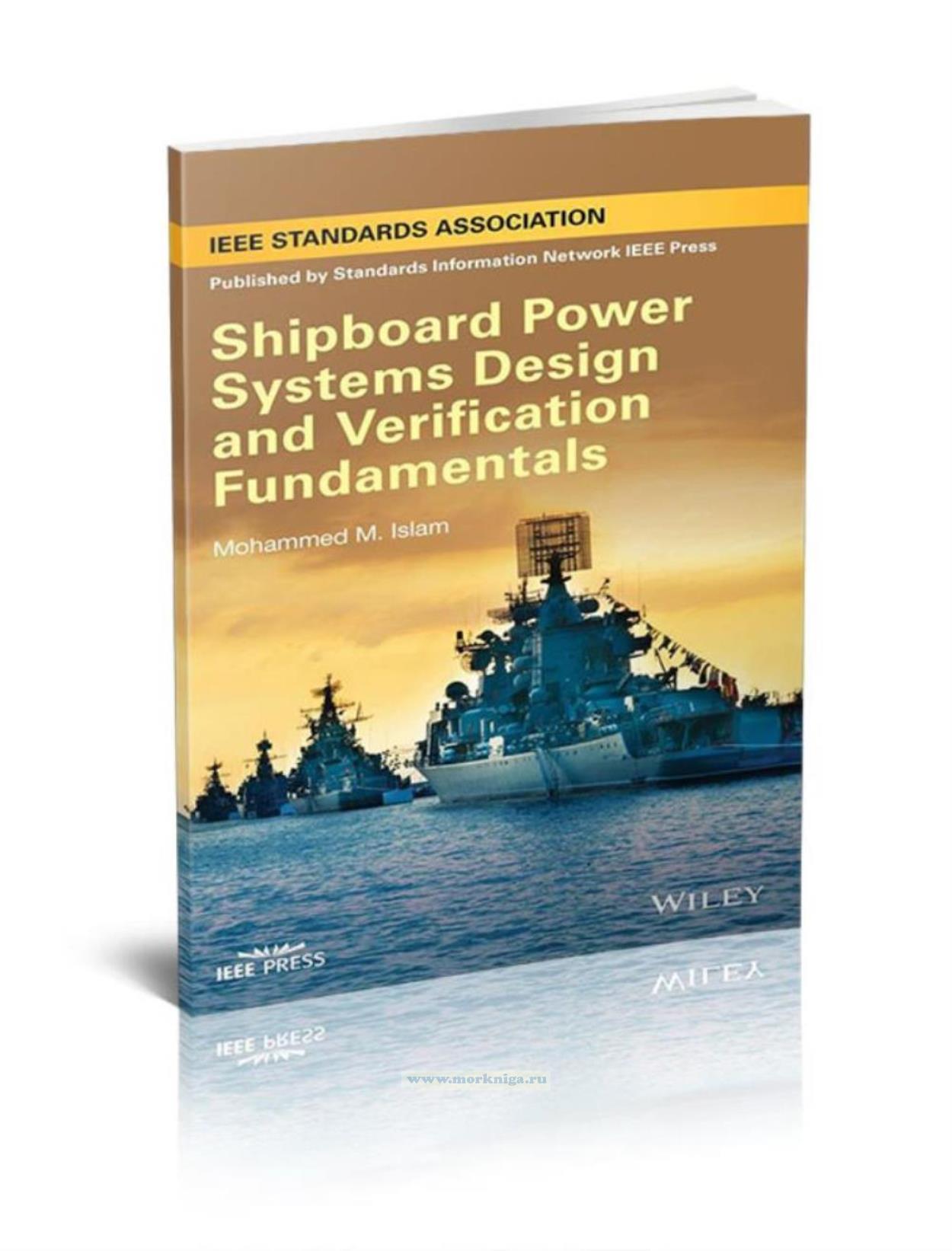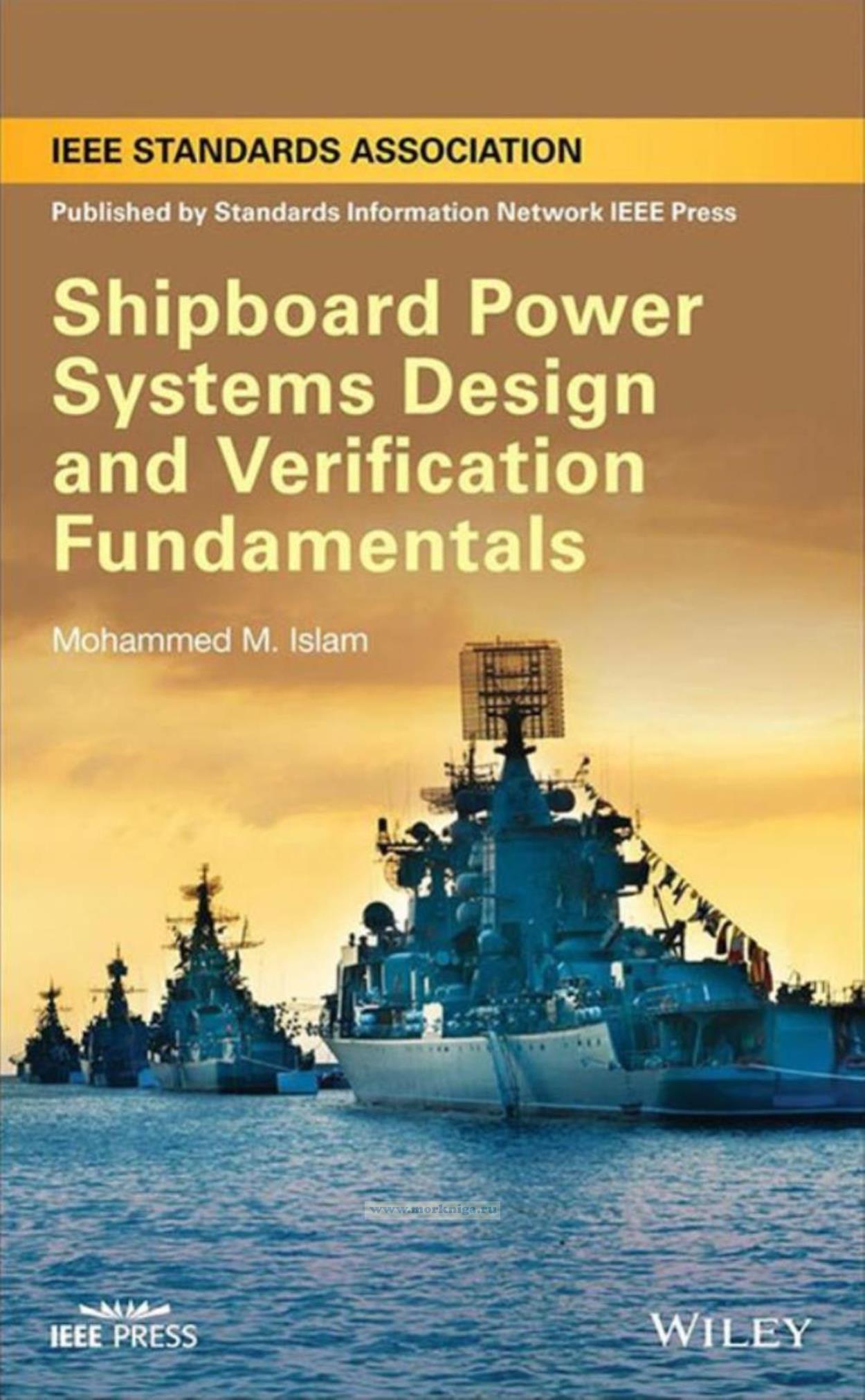Сб с 10 до 16
Shipboard Power Systems Design and Verification Fundamentals/Основы проектирования и проверки судовых энергетических систем
Издание на английском языке
Shipboard electrical system design and development requirements are fundamentally different from utility-based power generation and distribution requirements. Electrical engineers who are engaged in shipbuilding must understand various design elements to build both safe and energy-efficient power distribution systems.
This book covers all the relevant technologies and regulations for building shipboard power systems, which include commercial ships, naval ships, offshore floating platforms, and offshore support vessels. In recent years, offshore floating platforms have been frequently discussed in exploring deep-water resources such as oil, gas, and wind energy.
This book presents step-by-step shipboard electrical system design and verification fundamentals and provides information on individual electrical devices and practical design examples, along with ample illustrations to back them. In addition, Shipboard Power Systems Design and Verification Fundamentals: Presents real-world examples and supporting drawings for shipboard electrical system design. Includes comprehensive coverage of domestic and international rules and regulations (e.g. IEEE 45, IEEE 1580)Covers advanced devices such as VFD (Variable Frequency Drive) in detail. This book is an important read for all electrical system engineers working for shipbuilders and shipbuilding subcontractors, as well as for power engineers in general.
Contents
Preface
1. Overview
1.0 Introduction
1.1 Shipboard Power System Design Fundamentals
1.2 Ship Design Requirements
1.3 ETO Certification: MEECE
1.4 Legacy System Design Development and Verification
1.5 Shipboard Electrical System Design Verification and Validation (V&V)
1.6 IEEE 45 DOT Standards: Recommended Practice for Shipboard Electrical Installation
1.7 Other Rules and Regulations, and Standards in Support of IEEE 45 DOT Standards
1.8 Shipboard Ungrounded Power System
1.9 Shipboard Electrical Design Basics
1.10 Electrical Design Plan Submittal Requirements
1.11 ABS Rules for Building and Classing Steel Vessels
1.12 Shipboard Electrical Safety Considerations
1.13 High-Resistance Grounding Requirements for Shipboard Ungrounded Systems (See Chapter 9 for Details)
1.14 Shipboard Electrical Safety Considerations
1.15 Propulsion Power Requirements (IEEE Std 45-2002, Clause 7.4.2)
1.16 IMO-Solas Electric Propulsion Power Redundancy Requirements
1.17 Regulatory Requirements for Emergency Generator
1.18 USCG Dynamic Positioning (DP) Guidelines
1.19 IEC/ISO/IEEE 80005-1-2012: Utility Connections in Port-High Voltage Shore Connection (HVSC) Systems-General Requirements
1.20 Mil Standard 1399 Medium Voltage Power System Characteristics
1.21 Shipboard Power Quality and Harmonics (See Chapter 7 for Detail Requirements)
1.22 USCG Plan Submittal Requirements
1.23 ABS Rules for Building and Classing Steel Vessels (Partial Listing)
1.24 Design Verification and Validation
1.25 Remarks for VFD Applications Onboard Ship
2. Electrical System Design Fundamentals and Verifications
2.0 Introduction
2.1 Design Basics
2.2 Marine Environmental Condition Requirements for the Shipboard Electrical System Design
2.3 Power System Characteristics: MIL-STD-1399 Power Requirements
2.4 ABS Type Approval Procedure (Taken From ABS Directives)
2.5 Shipboard Electrical Power System Design Basics
2.6 Shipboard Electrical Standard Voltages
2.7 Voltage and Frequency Range (MIL-STD-1399)
2.8 Ungrounded System Concept (ANSI and IEC)
2.9 Concept Design
2.10 Design Features Outlined in
2.11 Protective Device–Circuit Breaker Characteristics
2.12 Fault Current Calculation and Analysis Requirement
2.13 Adjustable Drive Fundamentals
2.14 Fundamentals of ASD Noise Management
2.15 Electrical Noise Management (See Chapter 7 for Additional Details)
2.16 Motor Protection Solutions: DV/DT Motor Protection Output Filter
3. Power System Design, Development, and Verification
3.0 Introduction: Design, Development, and Verification Process
3.1 Typical Design and Development of Power Generation and Distribution (See Figure 3.1)
3.2 Failure Mode and Effect Analysis (FMEA): Design Fundamentals
3.3 Failure Mode and Effect Analysis (FMEA) Electric Propulsion System Diesel Generator: Design Fundamentals
3.4 Design Verification: General
3.5 Ship Service Power System Design: System-Level Fundamentals (Figure 3.2)
3.6 Single Shaft Electric Propulsion (Figure 3.3)
3.7 Electrical Generation and Distribution with Detail Design Information (Figure 3.4)
3.8 Electric Propulsion and Power Conversion Unit for Ship Service Distribution (Figure 3.5)
3.9 6600V and 690V Adjustable Speed Application with High-Resistance Grounding-1 (Figure 3.6)
3.10 MV and 690V Adjustable Speed Application with High-Resistance Grounding (Figure 3.7)
3.11 Fully Integrated Power System Design with Adjustable Speed Drive (Figure 3.8)
3.12 Variable Frequency Drive (VFD) Voltage Ratings and System Protection
3.13 Example 460V, Three-Phase, Full Wave Bridge Circuit Feeding Into a Capacitive Filter to Create a 650 VDC Power Supply
3.14 Special Cable and Cable Termination Requirements for Variable Frequency Drive Application
3.15 Harmonic Management Requirements for Variable Frequency Drive Application
3.16 Switchgear Bus Bar Ampacity, Dimension, and Space Requirements
3.17 MEECE (Management of Electrical and Electronics Control Equipment) Course Outline Requirements: USCG
4. Power Generation and Distribution
4.0 Introduction
4.1 Generation System Requirements
4.2 IEEE Std 45-2002, ABS-2002 and IEC for Generator Size and Rating Selection
4.3 ABS-2002 Section 4-8-2-3.1.3 Generator Engine Starting from Dead Ship Condition (Extract)
4.4 Additional Details of Sizing Ship Service Generators
4.5 Typical Generator Prime Mover
4.6 Generator: Typical Purchase Specification (Typical Electrical Propulsion System)
5. Emergency Power System Design and Development
5.0 Introduction
5.1 USCG 46 CFR Requirements: 112.05 (Extract Only)
5.2 IEEE STD 45-2002, Clause 6.1, General (Extract)
5.3 Emergency Source of Electrical Power: ABS 2010, 5.1.1 Requirement
5.4 ABS Emergency Generator Starting Requirement (ABS Rule for Passenger Vessels)
5.5 Typical Emergency Generation and Distribution System
5.6 Emergency Generator and Emergency Transformer Rating: Load Analysis (Sample Calculation)
5.7 Emergency Power Generation and Distribution with Ship Service Power and Distribution System
5.8 Emergency Transformer 450 V/120V (Per ABS)
5.9 Emergency Generator Starting Block Diagram
5.10 Emergency Generation and Distribution Design Verification
5.11 No-Break Emergency Power Distribution
6. Protection and Verification
6.0 Introduction: Protection System Fundamentals
6.1 Protective Device: Glossary
6.2 Power System Protections
6.3 Power System: Procedure for Protective Device Coordination
6.4 Fault Current Calculation Guidelines (Per USCG Requirements)
6.5 Overall Protection Synopsis
6.6 ANSI Electrical Device Numbering (for Device Number Details Refer to ANSI C.37.2)
6.7 Fault Current Calculations (Per USCG Requirements CFR 111-52-3(B) & (C))
6.8 Details for Figure 6.3 Typical EOL for MV Generator Protection System: Split Bus with Two Bustie Breakers
6.9 Details for Figure 6-4: Typical EOL for MV Generator Protection System: Split Bus with Two Bustie Breakers
6.10 Details for Figure 6.5 Typical for Transformer Protection Schematic
6.11 Details for Figure 6.10: Typical EOL for MV VFD Transformer Protection Schematic
6.12 Power System Dynamic Calculations
6.13 Protective Relay Coordination and Discrimination Study
7. Power Quality: Harmonics
7.0 Introduction
7.1 Solid-State Devices Carrier Frequency
7.2 MIL-STD-1399 Requirements
7.3 IEEE STD 519 Requirements (1992 and 2014 Versions)
7.4 Calculate the RMS Harmonic Voltage Due to the Respective Harmonic Current
7.5 Current Harmonic Matters
7.6 Harmonic Numbering
7.7 DNV Regulation: Harmonic Distortion
7.8 Examples of Typical Shipboard Power System Harmonic Current Calculations
7.9 Choice of 18-Pulse Drive versus 6-Pulse Drive with Active Harmonic Filter
7.10 Typical Software to Calculate Total Harmonic Distortion and Filter Applications
7.11 Harmonic Recommendations (IEEE 45.1 Partial Extract)
7.12 Harmonic Silencing and ARC Prevention (Curtsey of Applied Energy)
7.13 Applicable Power Quality Standards Include
8. Shipboard Cable Application and Verification
8.0 Introduction: Shipboard Cable Application
8.1 Cable Size Calculation Fundamentals
8.2 Shipboard Cable for ASD and VFD Applications
8.3 Cable Requirements Per IEEE Std 45
8.4 Cable Shielding Guide Per IEEE Std 1143
8.5 Cable: Physical Characteristics
8.6 Cable Insulation: Typical
8.7 Cable Ampacity
8.8 Commercial Shipboard Cable Circuit Designation
8.9 Example 1: Low-Voltage 600 V/1000V IEC Cable Details
8.10 Example 2: MV Voltage 8 KV/10 KV
8.11 Example 3: VFD Cable LV (600 V/100) and MV VOLTAGE (8 KV/10 KV)
8.12 Ground Conductor Size
8.13 Develop Math to Calculate the Ground Conductor for Parallel Run
8.14 Cable Designation Type (Typical Ship Service Cable Symbol or Designation)
8.15 Cable Color Code: Shipboard Commercial Cable
8.16 ASD (VFD) Cable Issues for Shipboard Application
8.17 ABS Steel Vessel Rule: Part 4, Chapter 8, Section 4: Shipboard Cable Application
8.18 Grounding Conductor Size: for Cable Rated 2 KV or Less for Single Run
9. Grounding, Insulation Monitoring Design, and Verification
9.0 Introduction
9.1 System Grounding Per IEEE 45
9.2 Selection of High-Resistance Grounding (HRG) System
9.3 IEEE 142 Ground Detection Requirements
9.4 IEC Requirements: Insulation Monitoring System
9.5 System Capacitance to Ground Charging Current Calculation (Taken From IEEE 142 Figs. 1.6 and 1.9)
9.6 Total System Capacitance Calculation
9.7 Calculate Capacitive Charging Current: (for a Typical Installation)
9.8 Capacitive Charging Current Calculation: Sample Calculation
9.9 Grounding Resistor Selection Guideline Per IEEE STD 32-1972
9.10 Grounding Resistor Duty Rating
9.11 Zigzag Grounding Transformers: IEEE STD 142 Section 1.5.2
9.12 Rating and Testing Neutral Grounding Resistors: IEEE STD 32-1972
9.13 Voltage Stabilizing Ground Reference (VSGR) Phaseback for Ground Detection (Curtsey of Applied Energy)
9.14 HRG Versus VSGR
9.15 Shipboard Ground Detection System Recommendations
10. Shore Power LV and MV Systems
10.0 Introduction
10.1 LV Shore Power System
10.2 MV (HV) Shore Power System
10.3 Low-Voltage Shore Power System
10.4 Four-Wire Grounded System LV Shore Power Connections
10.5 Medium-Voltage Shore Power System (MV)
10.6 Extract from IEC/ISO/IEEE 80005-1 Part 1: High-Voltage Shore Connection (HVSC) Systems HV Shore Power Requirements (Shore to Ship Power Quality and Protection Requirements)
11. Smart Ship System Design (S3D) and Verification
11.0 Introduction
11.1 Virtual Prototyping for Electrical System Design
11.2 Electrical Power System Smart Ship System Design Failure Mode and Effect Analysis
11.3 Marine Technology Society (MTS) Guidelines for DP Vessel Design Philosophy: Guidelines for Modu DP System and Commercial Ships
11.4 Additional Marine Technology Society (MTS) Requirements Applicable for Ship Design: (USCG Recognized MTS Requirements)
11.5 Condition-based Maintenance
11.6 FMEA Objectives: S3D Concept
11.7 Additional S3D Process Safety Features
12. Electrical Safety and Arc Flash Analysis
12.0 Introduction
12.1 Injuries Result from Electrical-Current Shorts
12.2 General Safety Tips for Working with or Near Electricity
12.3 Arc Flash Basics
12.4 Fundamentals of Electrical Arc and Arc Flash
12.5 Definitions Related to Arc Flash (Derived from NFPA 70E NEC, NFPA 70E, and IEEE STD 1580 for Shipboard Electrical Installations)
12.6 Causes of Electric Arc
12.7 Incident Energy
12.8 Incident Energy at Arc Flash Protection Boundary
12.9 The Flash Protection Boundary
12.10 Electrical Hazards: Arc Flash with Associated Blast and Shock
12.11 Shock Hazard
12.12 Hazard/Risk Categories (Derived from NFPE-70E)
12.13 Shipboard Electrical Safety Compliance Chart per NFPA 70E 2012 Table 130.7.C.9
12.14 Arc Flash: OSHA Requirements (29 CFR 1910.333)
12.15 Arc Flash: National Electrical Code (NEC) Requirements
12.16 Arc Flash: NFPA 70E 2012 Requirements
12.17 Arc Flash Boundary: NFPA 70E
12.18 Low-Voltage (50 V–1000 V) Protection (NFPA 70E 130.3 (A1))
12.19 Medium-Voltage (1000V and Above) (NFPA 70E 130.3 (A2))
12.20 Arc Flash: IEEE 1584 Requirements and Guidelines
12.21 Arc Flash: Circuit Breaker Time Currect Coordination-Overview
12.22 Arc Flash Calculation Analysis and Spreadsheet Deliverables
12.22.1 For Shipboard Arc Flash Analysis the Following Should be Included
12.23 Methods of Developing Analysis
12.24 Fault Current Analysis to Ensure Power System Component Protection Characteristics
12.25 Fault Current Calculation: Approximation for Arc Flash Analysis
12.26 Shipboard Fault Current Calculation Guidelines (per USCG Requirements)
12.27 Example Shipboard Fault Current Calculations (per USCG Requirements CFR 111-52-3(B) & (C))
12.28 Shipboard Power System Short-Circuit Current Calculation (Refer to US Navy Design Data Sheet 300-2 for Details)
12.29 Fault Current and Arc Flash Analysis as Required by NFPA 70E
12.30 Fault Current and Arc Flash Analysis Guide by IEEE 1584
12.31 Electrical Safety and Arc Flash Labeling (NFPA 70E)
12.32 Arc Flash Protection-Boundary
12.33 Sample Arc Flash Calculations: Spreadsheet-Excel Type
12.33.1 NFPA 70E 2009 Equation D.5.2 (A) for Arc Flash Calculation
12.34 Low-Voltage (50 V–1000 V) Protection (NFPA 70E 130.3 (A1))
12.35 Medium Voltage (1000V and Above) (NFPA 70E 130.3 (A2))
12.36 IEEE 1584-Based Arc Flash Calculations
12.37 Sample Shipboard Arc Flash Calculation Project
12.38 Fast-Acting Arc Management System: Arc Flash Mitigating Hardware Driven Time
12.39 Guidelines for Shipboard Personnel
Glossary
Index


 Судовые гироскопические приборы
Судовые гироскопические приборы  Электроснабжение объектов водного транспорта
Электроснабжение объектов водного транспорта  Суда обслуживающего флота. История, современность, перспективы. Аналитический обзор
Суда обслуживающего флота. История, современность, перспективы. Аналитический обзор